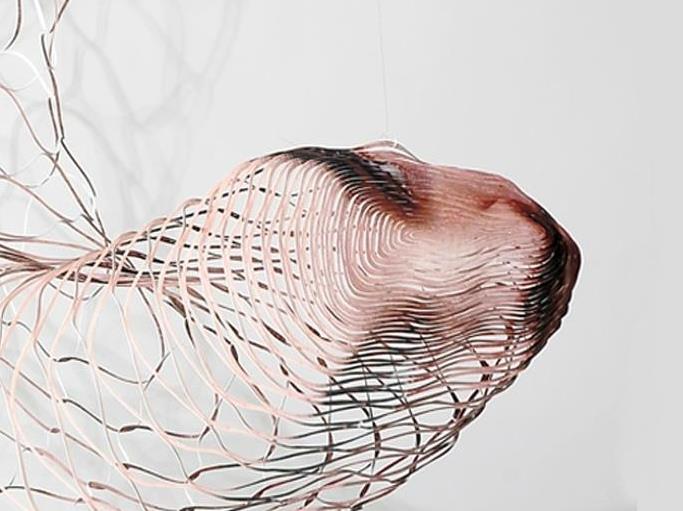Justine Khamar’s exhibition at Melbourne’s ARC One Gallery captured the imagination of audiences in 2013.
While it is increasingly difficult to define the visual arts at any one moment, what we can all agree is that the pace of things has been ratcheted up to a feverish pitch, as the pursuit of “the event” continues to interrupt the gallery landscape, from pop-up exhibitions to interventions, blockbusters to museums apps – no sector within the visual arts has remained untouched in 2013.
The year saw a change of government and with it arts funding and policy was herded in various directions. We witnessed cuts to arts education within the TAFE sector, universities continue to reduce their more traditional art programming in favour of researched based new technologies, while on the other hand 2013 marked the finalization of the national arts curriculum for schools, which NAVA lobbied for so vigorously over the past eight years.
But what of the shows?
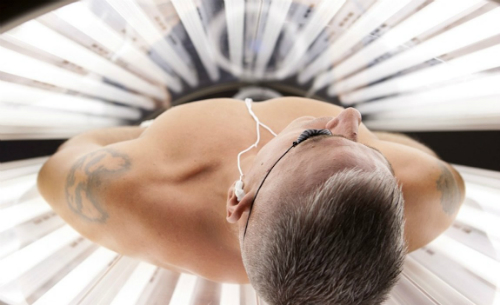
Simon Fujiwara’s performative installation Future/Perfect in the highly successful 13 Rooms.
Top 5 Spectaculars
1. You can’t get bigger than Melbourne Now, National Gallery of Victoria’s (NGV) local Blockbuster assembled over 250 commissioned, acquired and loaned works that explored the idea that a city is shaped by its artist, designers and architects.
2. With super-curators Hans Ulrich Obrist and Klaus Biesenbach at the helm, and hosted by veteran art project entrepreneur Kaldor Public Art Projects, 13 Rooms at Sydney’s Pier 2-3 turned the spotlight on performance art internationally. 100 local performers realised historically important works to record crowds over eleven days.
3.Cai Gui-Quang’s Falling Back to Earth at QAGOMA in Brisbane makes the list ‘for its sheer GOMA style spectacle’. Could three artworks be any more logistically challenging? Cai captivated audiences filling the gallery with 198 animals and a giant eucalypt. Two world premier commissions by a global arts star – now that is spectacular!
4. While ancient gold treasures from the Incas was the steal of NGA, it was the NGV’s traditional iteration that made the ‘Top 5′, Monet’s Garden from The Musee Marmottan Monet, Paris. Last winter these masterpiece of Monet’s lilies and gardens at Giverny came exclusively to Melbourne. And no matter how many times we’ve seen Monet’s lily’s – you told us you liked it!
5. Vying for the last spot were two exhibitions that couldn’t be any more different. Yoko Ono: War is Over presented at the Museum of Contemporary Art Australia (MCA) as part of the International Art Series in Sydney, and Turner from the Tate: The Making of a Master, which was organized in collaboration between the Art Gallery of South Australia (AGSA) and the National Gallery of Australia (NGA). The latter won for its reach and the fact that audiences were so very split on opinions over the Ono show – loving it with popularist zeal or dismissing it as ‘inflated celebrity triviality’. As one punter described, ‘It’s annoying to have a major institution treat you like you are completely stupid.’
Spectacular is no longer exclusive to the Blockbuster, and this year our state institutions and public galleries presented a eurdite and expanding program of exhibition. It was a tough call.
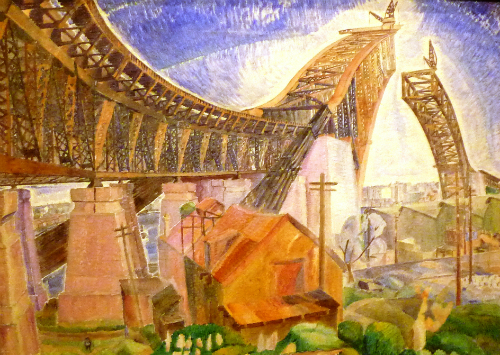
Grace Cossington Smith’s The Bridge in-Curve, 1930 in the well attended exhibition Sydney Moderns at AGNSW
Top 5 Exhibitions at Public Institutions
1. Sydney Moderns was conclusively heralded top of the list. Presented by the Art Gallery of New South Wales (AGNSW) it superbly traced our artistic heritage from the 1920s and 30s, an era of great change and influence.
2. Museum of Old and New Art (MONA) in Hobart has consistently surprised, enchanted and drawn audiences in their droves, and their most recent collection show The Red Queen has again captured the eye of the art world. 75% of the museum was rehung and added to with 15 new commissions for this exhibition, which investigated the evolutionary process of making.
3. Set to tour abroad next year, ‘My Country, I Still Call Australia Home: Contemporary Art from Black Australia’ curated by the QAGOMA team, was a provocative and passionate survey of Aboriginal and Torres Strait art from the last few decades.
4. Falling a bit between the cracks of categories, Japanese artist’s Ryoji Ikeda immersive installation test pattern at Sydney’s Carriageworks, perhaps was the most posted “selfie” for 2013. Presented in collaboration with ISEA2013 and Vivid Sydney, it was a kind of electric magnet that drew audience to its obscure location without a second thought.
5. Monika Sosnowska’s Regional Modernities at the Australian Centre for Contemporary Art (ACCA) in Melbourne was the southern hemisphere debut of this acclaimed Polish artist – and it was duly received. Her large psychologically charged architectural installations engorged ACCAs four galleries playing off the gallery’s angular exterior.
Technically falling in 2012 closing off the year as the summer spectaculars, Francis Bacon: Five Decades at AGNSW and Anish Kapoor at the MCA were exhibitions that continued into 2013 with a bang – and clearly left an impression on my brains trust insisting they were highlights of the year!
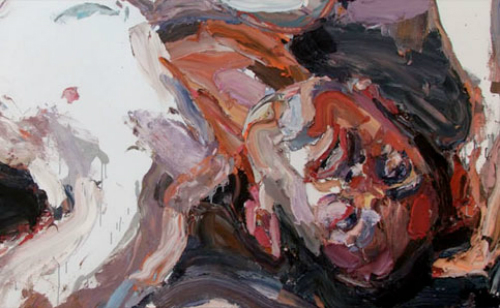
Ben Quilty’s After Afghanistan has drawn phenomenal crowds across its tour venues this year.
Top Shows at the Edges:
1. Ben Quilty: After Afghanistan. This nationally touring exhibition of Quilty’s portraits of returning soldiers as Official War Artist, has been flocked by visitors as it has moved across four venues in 2013, kicking off at the NAS Gallery, National Art School in Sydney in a blaze of publicity. The tour continues through regional Australian in 2014.
2. After nearly 50-years packed in boxes of a New York university storeroom, 119 pieces of Stolen Generation artwork returned to Australia in 2013 for the exhibition Koolark Koort Koorliny (Heart ComingHome) presented by Curtin University Gallery. Representatives from The Herbert Mayer Collection of Carrolup Artwork from Colgate University in New York Colgate headed to Perth to sign a deal with Curtin University signalling the repatriation of the artworks Curtin University Vice Chancellor Professor Jeanette Hacket said, ‘We are grateful that Colgate sees the deep and enduring value in returning the art to Noongar country.’
3. Melbourne-based Daniel Crooks rocked Adelaide with the survey exhibition at the Samstag Museum of Art, a project in partnership with the Adelaide Film Festival. Central to the show was a new commission 5-channel digital video that responded to the unique architecture of the gallery.
4. Brisbane-based husband and wife collaborative Alfredo and Isabel Aquilizan also captured audiences with their first Australian survey Fragments: another country, at QUT Art Museum in Brisbane.
5. The University of Queensland National Artists’ Self-Portrait Prize: remix. post. connect. made the list for ‘its channeling of the social media zeitgeist into art.’ It is still showing at the UQ Art Museum, St Lucia, Brisbane.
6. Roy Jackson: Retrospective 1963-2013 at the Drill Hall Gallery, Australian National University, Canberra, curated by Terence Maloon and Sioux Garside, was shaped in close consultation with the artist before his death this year. (JMD)

Source: Sydney Contemporary.
Top 5 Exhibitions at Commercial Galleries
1. Sydney Contemporary 13 art fair wore the crown leading activities in the commercial sector, a sensational first effort for this world-class fair that has not only defined Sydney’s contemporary scene but positioned Australia as a vital and vibrant market.
2. Justine Khamar’s sculptures at Melbourne’s ARC One Gallery created a stir. Titled Reconstructure her hand-cut and rearranged photographs are compelling visually (pictured top). Definitely, an artist to watch.
3. Timed with the announcement of the Sydney Ball’s 80th birthday and $1M gift to the University of South Australia, Sydney gallery Sullivan + Strumpf unveiled a rare collection of oversized Stain paintings stretching from 1971-1980.
4. Daniel Templeman’s minimal yet boldly huge sculptural intervention at Brisbane’s Spiro Grace Art Rooms (SCAR), posed the age old question with renewed elegance: Can the object be the subject? Whether it is a large-scale concrete sculpture or a delicate carbon-transfer drawing, Templeman invites us to question the artefact’s construction, physicality and finish. Compared with Simone Eisler’s exhibition the month prior in the same space, an equally celebrated exhibition in 2013, one starts to look with interest on this gallery as it becomes increasingly a serious player in the Queensland scene (opened 2010).
5. Opening Dominik Mersch Gallery’s new Sydney space was Marion Borgelt’s exhibition So Near So Far, an artist deep into her career and yet the work just keeps getting better.
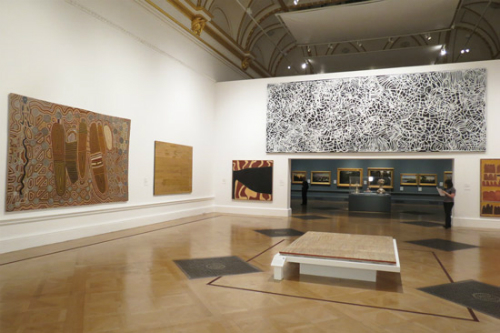
The hang of Australia at the Royal Academy. Photo Katherine Tyrrell; Source: markingmark.blogspot
Dud of 2013
It seems that Australia did not show its best face abroad this year, with the NGA’s Royal Academy. While few of us saw this exhibition we heard the critics across the seas describing it as ‘weedy, provincial and all too European’. A wasted opportunity.
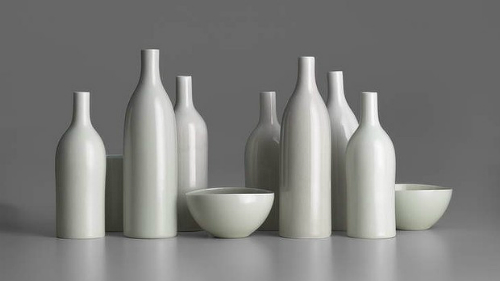
Australia lost two sublime ceramic artists this year, Marea Gazzard and Gwen Hanson-Pigott whose work is pictured above.
Vale 2013
1. Deeply respected medical practitioner and founded of Laverty Pathology, Dr. Colin Laverty, died 9 February following a battle with cancer. The Lavertys amassed an outstanding collection of contemporary indigenous and non-indigenous art, gifting more than 130 works to Australian art museums during his lifetime, with an additional 266 works auctioned in March at the MCA.
2. One of our great sculptors, Bert Flugelman died 26 February. While he worked across several media including painting and printmaking, it was his large formalist stainless sculptures that he is best remembered by.
3. Adelaide-born painter Jeffrey Smart died at his home in Italy on 20 June aged 91.
4. Gwyn Hanssen Pigott died of a stroke on 5 July in London where she had lived for many years. Born in Ballarat (VIC), she maintained a studio in Ipswich (QLD) during her career as a ceramic artist.
5. Roy Jackson died a few days short of his 69th birthday at his home in Wedderburn (NSW) in July.
6. Long term Melbourne patron of the arts Mrs Loti Smorgon passed away in August. The Smorgon’s generosity extended to the significant gift of 154 contemporary Australian works to Sydney’s MCA in the mid 1990s.
7. A week before a solo exhibition in Los Angeles, Matt Doust died from an epileptic seizure on 28 August, aged just 29. Doust, who was born in California, grew up in Perth, his hyper-real portraits garnering international attention. He had only recently moved to LA.
8. Brisbane-born abstractionist John Peart died on his property in Wedderburn (NSW) 10 October, aged 67, after a tragic accident in the wake of local bushfires. Among his accolades, he won the AGNSW 1997 Wynne Prize and the 2000 Sulman Prizes.
9. Marea Gazzard died peacefully on 28 October after prolonged illness. A revolutionary potter who changed the way we perceived ceramics, she advocated at the highest levels within the Craft movement and for women’s place in the art world. Her serene yet strong sculptural forms were an echo of the woman herself.
10. Landscape painter Leonard Long died 3 November at the ripe age of 102. It is said he painted up to his last years, his strong connections with the Canberra region carrying through his landscapes. He died in Melbourne.
11. Yvonne Boyd (née Lennie), widow of the celebrated artist Arthur Boyd, died in Melbourne on 13 November. An artist in her own right, she studied the Royal Academy (now known as the Victorian College of the Arts), and was a talented painter.
12. Gunter Christmann passed away 19 November, known for his hard edge colourfiled paintings of the 1960s, and later his “float” or “sprinkle” paintings. He rose to prominence in the landmark exhibition The Field (1968) at the NGV. He immigrated to Australia in 1959.
13. Writer Jeremy Eccles reminded me that we often forget to drawn our Aboriginal artists into such salutes to the year past, his obituary on Paddy Japaljarri Stewart, also known as Cookie Stewart, was an important painter in those early Papunya days painting the Yuendumu Doors. His etchings of 2001 won the 16th National Aboriginal and Torres Strait Islander Art Award for works on paper.
14. Always carving his own way, Martin Sharp caps our list for the year, ending his long battle emphysema on 1 December, when he died in his Bellevue Hill home in Sydney aged 71. His images of Luna Park, Tin Tim, Cream record covers and scrawling Eternity will live long for their graphic genius.

Top Rants: 10 telling comments we heard in 2013
1. ‘Overall the slide into chaos is continuing, there will be more gallery closures, the shape of the future art world isn’t visible, even in outline yet, but you can be sure it will be very different from now.’
2. ‘Newcastle Art Gallery needs to have the art world behind them and Ron Ramsay needs to be reinstated and this witch-hunt has to end. Ridiculous!’
3. ‘cementa_13 at Kandos has the potential to be the new Mildura Triennial. Impressive that the very first one was so amazingly good.’
4. ‘Disappointing that the Indigenous art market hasn’t bounced back yet. Should, as it is some of the most interesting art being made.’
5. ‘Most disappointing feature of the art world is connoisseurship has almost disappeared and ‘decorative’ art (as opposed to the Decorative arts) is way too popular.’
6. ‘Continued interest in the art book … and recognition of its necessity for artists working overseas. A new contemporary art book distributor would be useful!’
7. ‘I am totally over pop-ups and entertainment driven art events, pretending to be art. An artist works in isolation and when they bring their art to the world they want it to be considered, not a backdrop for a night out.’
8. ‘Every man and his dog has a PhD these days, because jobs are scarce and competition is fierce.’
9. The career of John Clark who pioneered the field of Modern and Contemporary Asian Art History was honoured by the aptly named Tilting the World Symposium on the occasion of his retirement from Sydney University…But has the tilt stopped there? What new ground are we breaking in this so-called Asian Century?
10. ‘So many arts orgs out there struggling financially and see a great opportunity in cultural tourism, but how do we make that balance around taking up business opps without compromising creative innovation process?’
